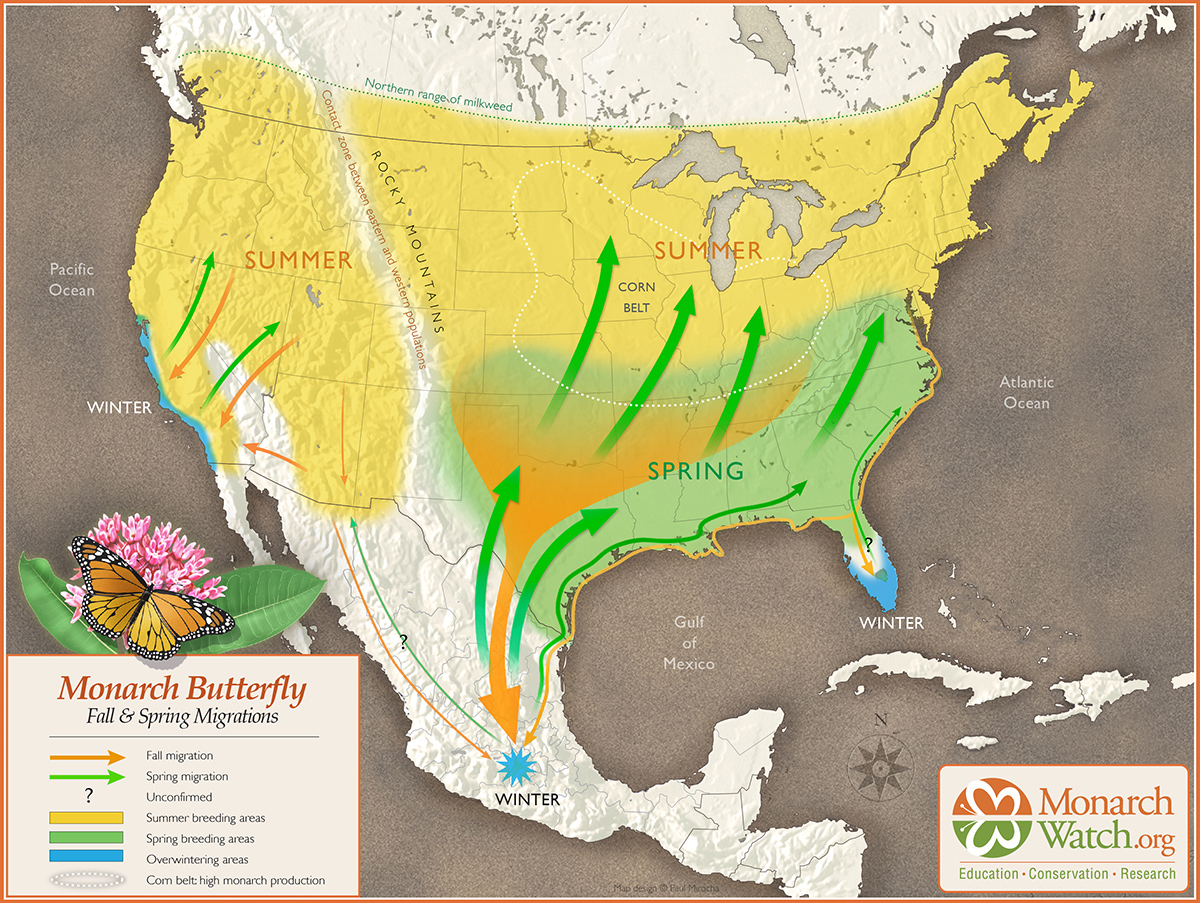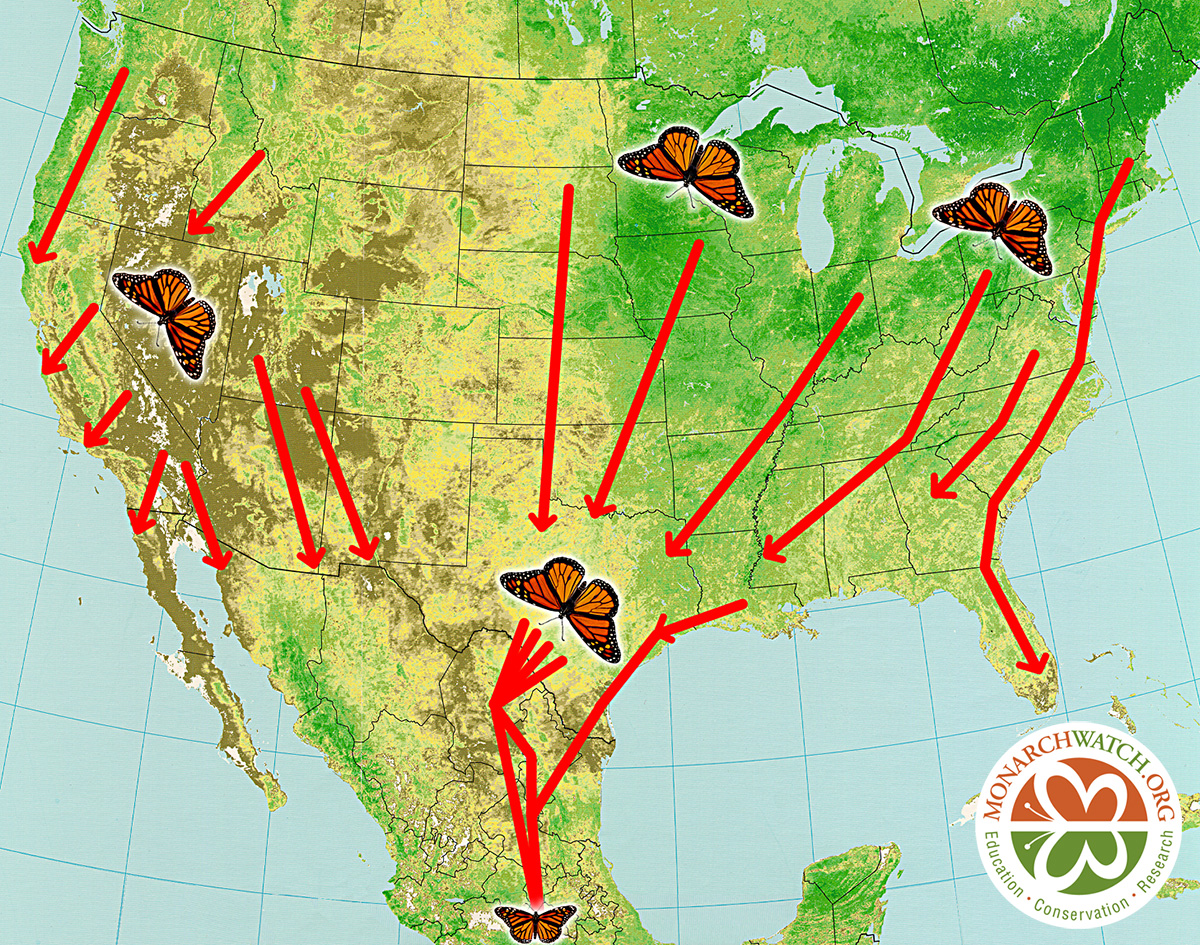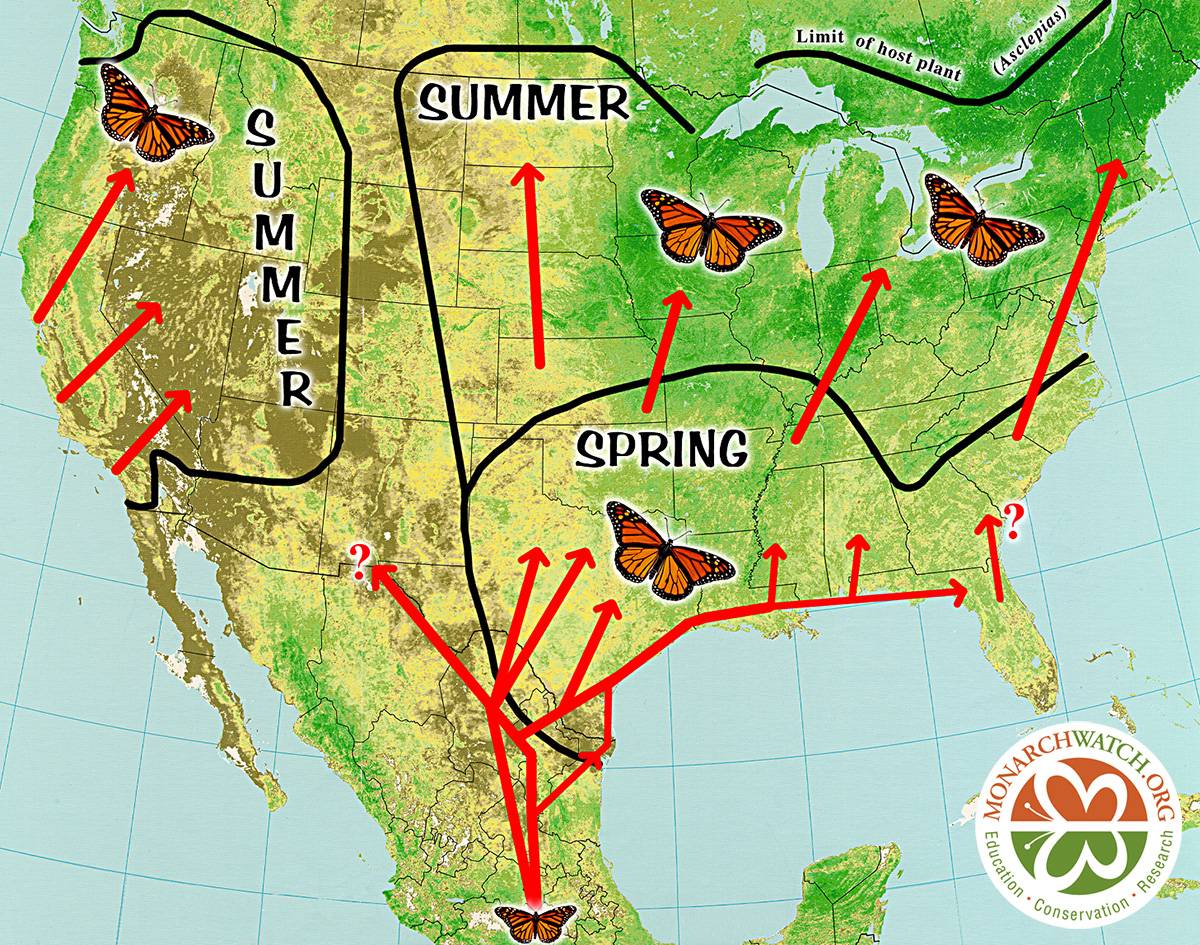 We have created a comprehensive map representing both the fall and spring migrations both east and west of the Rocky Mountains. To the extent possible, the map is based on data. Nevertheless, our knowledge of the distribution and abundance of monarchs in some seasons is lacking for certain areas of the country. In these cases, our interpretations are based on what monarchs are doing in surrounding areas. You can read more about our Two-way Monarch Migration Map via our blog. A poster version of this Monarch Migration Map is also available via the Monarch Watch Shop (shop.monarchwatch.org)  |
FALL MIGRATION |
|
Unlike most other insects in temperate climates, Monarch butterflies cannot survive a long cold winter. Instead, they spend the winter in roosting spots. Monarchs west of the Rocky Mountains travel to small groves of trees along the California coast. Those east of the Rocky Mountains fly farther south to the forests high in the mountains of Mexico. The monarch's migration is driven by seasonal changes. Daylength and temperature changes influence the movement of the Monarch. In all the world, no butterflies migrate like the Monarchs of North America. They travel much farther than all other tropical butterflies, up to three thousand miles. They are the only butterflies to make such a long, two way migration every year. Amazingly, they fly in masses to the same winter roosts, often to the exact same trees. Their migration is more the type we expect from birds or whales. However, unlike birds and whales, individuals only make the round-trip once. It is their children's grandchildren that return south the following fall. Some other species of Lepidoptera (butterflies and moths) travel long distances, but they generally go in one direction only, often following food. This one-way movement is properly called emigration. In tropical lands, butterflies do migrate back and forth as the seasons change. At the beginning of the dry season, the food plants shrivel and the butterflies leave to find a moister climate. When the rains arrive, the food plants grow back and the butterflies return. The Fall Migration (September - November). This figure is an interpretation of the routes taken by Monarchs during the Fall migration. The pathways are based on tag recoveries and observations of Migrating Monarchs.  When the late summer and early fall Monarchs emerge from their pupae, or chrysalides, they are biologically and behaviorally different from those emerging in the summer. The shorter days and cooler air of late summer trigger changes. In Minnesota this occurs around the end of August. Even though these butterflies look like summer adults, they won't mate or lay eggs until the following spring. Instead, their small bodies prepare for a strenuous flight. Otherwise solitary animals, they often cluster at night while moving ever southward. If they linger too long, they won't be able to make the journey; because they are cold-blooded, they are unable to fly in cold weather. Fat, stored in the abdomen, is a critical element of their survival for the winter. This fat not only fuels their flight of one to three thousand miles, but must last until the next spring when they begin the flight back north. As they migrate southwards, Monarchs stop to nectar, and they actually gain weight during the trip! Some researchers think that Monarchs conserve their "fuel" in flight by gliding on air currents as they travel south. This is an area of great interest for researchers; there are many unanswered questions about how these small organisms are able to travel so far. Another unsolved mystery is how Monarchs find the overwintering sites each year. Somehow they know their way, even though the butterflies returning to Mexico or California each fall are the great-great-grandchildren of the butterflies that left the previous spring. No one knows exactly how their homing system works; it is another of the many unanswered questions in the butterfly world. |
OVERWINTERING SITES |
|
Monarchs east of the Rockies migrate each year to the Transvolcanic mountains of central Mexico. Millions and millions of butterflies from the central and eastern Canadian provinces and the eastern and midwestern United States fly south to Mexico. Their flight pattern is shaped like a cone, as they come together and pass over the state of Texas on their way south. In massive butterfly clouds, they sweep up into the mountain ranges of central Mexico. In 1975 the scientific community finally tracked down the wintering sites of the Monarch in Mexico. Until then, the Monarch butterflies' winter hideouts had been a secret known only to local villagers and landowners. The sites the Monarchs use during the winter have particular characteristics that enable their survival. These characteristics are important because they provide the Monarch with the right overwintering conditions. Trees on which to cluster are one of the most important elements of the sites. The climate and the whole surrounding area are also important. Nearby trees, streams, underbrush, and fog or clouds all form an intricate natural ecosystem that is the monarchs' winter habitat. These conditions are found in oyamel fir forests, which occur in a very small area of mountain tops in central Mexico. Overwintering sites are about 3000 meters (nearly 10,000 feet) above sea level, and are on steep, southwest-facing slopes. In particular, the butterflies need a cool place. When they are cool, they don't metabolize, or use up, their energy reserves as fast. They also need to be protected from snow and winds. The surrounding trees serve as a buffer to the winds and snow. Because they also need water for moisture, the fog and clouds in this mountainous region provide another important element for their survival. The butterflies choose spots that are close to but not quite freezing. They cluster together, covering whole tree trunks and branches, and cling to fir and pine needles. The forest floor in the overwintering sites is covered with young trees, shrubs, lichens and moss. When Monarchs fall out of the trees and are too cold to fly back up, they can sometimes crawl to the lower bushes to avoid predators. The tall trees make a thick canopy over their heads. Protective trees and bushes soften the wind and shield the butterflies from the occasional snow, rain, or hail. Fog and clouds settle on the Monarch groves. On sunny days, they often warm up enough to fly to nearby water where they will drink. They must fly back to the roost before getting too cold, and one can sometimes see them take off in flight, heading back to the roosts as soon as a cloud passes over. Each of the above elements is important to the butterflies, and makes up the Monarch habitat - trees in which to roost, other trees and shrubs to protect them, the cool air, and the presence of water. |
SPRING MIGRATION |
|
As winter ends and the days grow longer, the Monarchs become more active, beginning to mate and often moving to locations lower on the mountainsides. They leave their Mexican roosts during the second week of March, flying north and east looking for milkweed plants on which to lay their eggs. These Monarchs have already survived a long southward flight in the fall and winter's cold; they have escaped predatory birds and other hazards along the way, and are the only Monarchs left that can produce a new generation. If they return too early, before the milkweed is up in the spring, they will not be able to lay their eggs and continue the cycle. The migrating females lay eggs on the milkweed plants they find as they fly, recolonizing the southern United States before they die. Soon the first spring caterpillars hatch and metamorphose into orange and black adults. It is these newly emerged Monarchs, the offspring of the butterflies that made the fall journey, that recolonize their parents' original homes. Summer Monarchs live a much briefer life than the overwintering generation; their adult lifespan is only three to five weeks compared with eight or nine months for the overwintering adults. Over the summer there are three or four generations of Monarch butterflies, depending on the length of the growing season. Since each female lays hundreds of eggs, the total number of Monarch butterflies increases throughout the summer. Before the summer ends, there are once again millions of Monarchs all over the U.S. and southern Canada. The Spring Migration (March - June). This figure is an interpretation of the routes taken by Monarchs during the Spring migration. The pathways are based on tag recoveries and observations of Migrating Monarchs.  |
All material on this site © Monarch Watch unless otherwise noted. Terms of use.
Monarch Watch (888) TAGGING - or - (785) 864-4441
monarch@ku.edu
 Monarchs west of the Rocky Mountains return to the California coast, where they roost in eucalyptus trees, Monterey pines and Monterey cypresses. Long ago, the Monarchs roosted in sycamores, too. But with the dramatic rise in southern California's human population, trees were cut to make room for shopping malls, freeways and houses, and the sycamores have almost disappeared. The remaining clustering sites lie in bays sheltered from wind, or farther inland where they are protected from storms. Scientists estimate that the California Monarchs make up about 5 percent of the overall worldwide Monarch population.
Monarchs west of the Rocky Mountains return to the California coast, where they roost in eucalyptus trees, Monterey pines and Monterey cypresses. Long ago, the Monarchs roosted in sycamores, too. But with the dramatic rise in southern California's human population, trees were cut to make room for shopping malls, freeways and houses, and the sycamores have almost disappeared. The remaining clustering sites lie in bays sheltered from wind, or farther inland where they are protected from storms. Scientists estimate that the California Monarchs make up about 5 percent of the overall worldwide Monarch population.